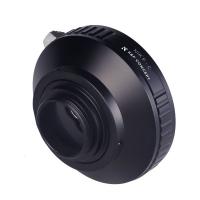What Does Amoeba Look Like Under A Microscope ?
Under a microscope, an amoeba appears as a single-celled organism with a shape that is constantly changing. It typically has a clear, jelly-like body with a granular appearance. Amoebas have a flexible cell membrane that allows them to extend and retract their pseudopods, which are temporary projections of the cell that aid in movement and feeding. The size of an amoeba can vary, but they are generally microscopic, ranging from about 0.02 to 0.3 millimeters in diameter.
1、 Shape and Structure of Amoeba Cells
Amoebas are single-celled organisms that belong to the phylum Amoebozoa. When observed under a microscope, they exhibit a distinct shape and structure that sets them apart from other microorganisms.
The most notable feature of an amoeba is its shape, which is often described as irregular or blob-like. Unlike other cells with a fixed shape, amoebas have the ability to change their shape constantly. This is due to their flexible cell membrane and the presence of pseudopodia, which are temporary extensions of the cell that allow movement and engulfment of food particles.
Under high magnification, the internal structure of an amoeba becomes visible. The cytoplasm, which fills the cell, appears granular and contains various organelles such as mitochondria, Golgi apparatus, and endoplasmic reticulum. The nucleus, which controls the cell's activities, is typically large and centrally located within the cytoplasm.
Amoebas also possess a contractile vacuole, which helps regulate water balance within the cell. This organelle can be observed as a clear, spherical structure that periodically expands and contracts to expel excess water.
Recent advancements in microscopy techniques have allowed for more detailed observations of amoebas. For instance, fluorescent labeling can be used to visualize specific organelles or proteins within the cell. This has provided insights into the dynamic processes occurring within amoebas, such as the movement of vesicles or the rearrangement of cytoskeletal components.
In conclusion, when viewed under a microscope, amoebas exhibit a unique shape and structure. Their ability to change shape, presence of pseudopodia, and distinct organelles make them fascinating subjects for microscopic study. Ongoing research continues to shed light on the intricate workings of these remarkable single-celled organisms.

2、 Cytoplasmic Streaming in Amoeba
Amoebas are single-celled organisms that belong to the phylum Amoebozoa. When observed under a microscope, they appear as irregularly shaped blobs with a constantly changing outline. The shape of an amoeba is flexible and can vary depending on its movement and feeding activities. Typically, an amoeba has a clear, gel-like cytoplasm that fills its cell membrane.
One of the most fascinating features of amoebas is their ability to exhibit cytoplasmic streaming. Cytoplasmic streaming, also known as cyclosis, is the movement of the cytoplasm within the cell. This movement is facilitated by the presence of a network of microfilaments and microtubules that traverse the cytoplasm. These structures act as tracks for the transport of organelles, nutrients, and waste materials.
Under the microscope, cytoplasmic streaming in amoebas can be observed as a continuous flow of granules and vesicles moving in a specific direction. This movement is often described as a slow, steady streaming motion. The direction of the streaming can change as the amoeba alters its shape or changes its direction of movement.
Recent studies have shed light on the molecular mechanisms behind cytoplasmic streaming in amoebas. It has been found that actin, a protein involved in cell movement, plays a crucial role in generating the force required for cytoplasmic streaming. Actin filaments form a network throughout the cytoplasm, and the interaction between these filaments and myosin motor proteins generates the force that propels the cytoplasmic flow.
In conclusion, when observed under a microscope, amoebas appear as irregularly shaped blobs with a clear, gel-like cytoplasm. Cytoplasmic streaming, a fascinating phenomenon, can be observed as a slow, steady flow of granules and vesicles within the amoeba's cytoplasm. Recent research has revealed the involvement of actin and myosin in generating the force required for cytoplasmic streaming.

3、 Pseudopodia Formation and Movement in Amoeba
Amoebas are single-celled organisms that belong to the phylum Amoebozoa. When observed under a microscope, they appear as irregularly shaped blobs with a gelatinous consistency. The size of an amoeba can vary, but they typically range from 0.02 to 0.03 millimeters in diameter.
One of the most distinctive features of amoebas is their ability to form and extend pseudopodia, which are temporary projections of the cell membrane. These pseudopodia allow amoebas to move and capture food. When an amoeba extends a pseudopodium, it pushes its cytoplasm forward, causing the cell membrane to bulge outwards. The pseudopodium then attaches to a surface, and the rest of the cell follows, allowing the amoeba to move in the direction of the pseudopodium.
The movement of an amoeba is characterized by a flowing motion, as it constantly extends and retracts its pseudopodia. This process is known as amoeboid movement. The pseudopodia can also change shape and direction, allowing the amoeba to navigate its environment and engulf prey.
Recent research has shed light on the molecular mechanisms behind pseudopodia formation and movement in amoebas. It has been discovered that actin, a protein involved in cell movement, plays a crucial role in the extension and retraction of pseudopodia. Actin filaments assemble at the leading edge of the pseudopodium, providing structural support and generating the force necessary for movement. Additionally, other proteins, such as myosin, are involved in the contraction and retraction of the pseudopodia.
In conclusion, when observed under a microscope, amoebas appear as irregularly shaped blobs with the ability to form and extend pseudopodia. These pseudopodia allow amoebas to move and capture food through a flowing motion known as amoeboid movement. Recent research has provided insights into the molecular mechanisms behind pseudopodia formation and movement, highlighting the role of actin and other proteins.

4、 Nucleus and Nuclear Division in Amoeba
Amoebas are single-celled organisms that belong to the phylum Amoebozoa. When observed under a microscope, they appear as irregularly shaped blobs with a constantly changing outline. The shape of an amoeba is flexible and can vary depending on its movement and feeding activities. The cell membrane of an amoeba is thin and transparent, allowing for easy observation of its internal structures.
One of the most prominent features of an amoeba under a microscope is its nucleus. The nucleus is a spherical or oval-shaped structure located in the center of the cell. It is surrounded by a nuclear membrane, which separates it from the cytoplasm. The nucleus contains the genetic material of the amoeba, including its DNA.
Under certain conditions, amoebas undergo nuclear division, a process known as mitosis. During mitosis, the nucleus of the amoeba divides into two identical nuclei. This is followed by the division of the cytoplasm, resulting in the formation of two daughter cells. This process allows amoebas to reproduce asexually and increase their population.
Recent advancements in microscopy techniques have provided more detailed insights into the structure and behavior of amoebas. For instance, high-resolution microscopy has revealed the presence of subcellular structures within the amoeba, such as contractile vacuoles, food vacuoles, and pseudopodia. These structures play crucial roles in the movement, feeding, and waste elimination processes of the amoeba.
In conclusion, when observed under a microscope, amoebas appear as irregularly shaped blobs with a constantly changing outline. The nucleus is a prominent feature, located in the center of the cell and surrounded by a nuclear membrane. Recent advancements in microscopy techniques have allowed for a more detailed understanding of the internal structures and behaviors of amoebas.





























There are no comments for this blog.